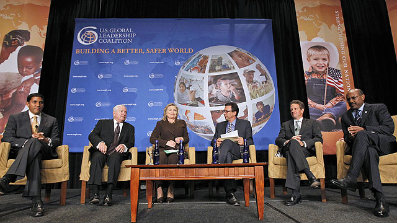 FoxNews.com story by way of Chris Ridlon, a military officer. Poll of US military officers in conjunction with conference held by US Global Leadership Coalition, with Clinton, Gates, Geithner and Shah (USAID) all up on stage together.
FoxNews.com story by way of Chris Ridlon, a military officer. Poll of US military officers in conjunction with conference held by US Global Leadership Coalition, with Clinton, Gates, Geithner and Shah (USAID) all up on stage together.
The sea-change in thinking on 3D (defense, diplomacy, development) shows it's here to stay.
Nearly 90 percent of active and retired military officers say diplomacy and development are at least partly helpful to achieve U.S. national security objectives as opposed to just a strong military presence, a poll out Monday shows.
The U.S. Global Leadership Coalition also found among the 606 active duty and retired officers surveyed that 83 percent also think humanitarian efforts such as food assistance and health, education and economic development lend to an effective strategy.
Why so strong? For the same reason why I felt comfortably making the SysAdmin argument by 2001: we're talking about a generation of officers who've spent darn near their entire careers involved in this stuff (crisis response, humanitarian response, nation-building, counter-insurgency) and the military-heavy approach simply does not cover enough of the gamut.
And it's not just the military saying "more aid please." Note the realization that interplay is required.
The poll shows mixed opinions among the military about who is better to lead missions relating to non-military action, including providing security for local populations, training police and armed forces, offering assistance to civil institutions, building infrastructure and working with local leaders on development. The first two missions should be the work of military or the military with civilian agencies, the poll showed, while the last three should more likely be civilian or civilian mixed with military coordination, the numbers show.
And that reality is what pushed me to propose the Department of Everything Else in "Blueprint" (2005). Part of that is realizing that USAID will remain an afterthought if buried inside State, and part is realizing that setting up ad hoc structure each time these elements come together isn't working. Plus, if it's always left to the military to organize, the military will be left with too much to do. So you need serious bureaucratic structure that--in effect--represents a meeting ground for the three. Otherwise you get a mil-heavy operation right up to the point where you hand off to an overwhelmed State (going on now in Iraq). You need the bridging entity.
And as I've said all along, the DoEE is more of a command structure with budgetary authority than a department in a classic sense. When unused (not that likely a situation), it can be the proverbial command-in-waiting with a skeleton staff, to which State, USAID and military personnel/units can be loaned out as required. But you create a bureaucratic center of gravity that both signals our intent and gives potential allies (including the UN) an element with which they can cooperate that isn't Defense and isn't State but something in between.